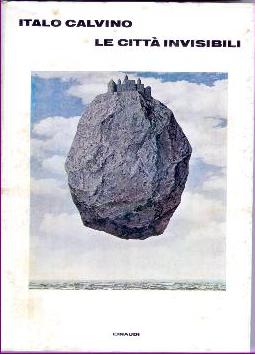Invisible Cities
From Wikipedia, the free encyclopedia
| Invisible Cities | |
 Cover of first English edition (hardcover) |
|
| Author | Italo Calvino |
|---|---|
| Original title | Le città invisibili |
| Translator | William Weaver |
| Country | Italy |
| Language | Italian |
| Genre(s) | novel |
| Publisher | Harcourt Brace Jovanovich (first English edition) |
| Publication date | 1972 (Italian) 1974 (English) |
| Media type | print (hardcover & paperback) |
| Pages | 165 pp (first English edition) |
| ISBN | ISBN 0-151-45290-3 (first English edition) |
Invisible Cities (Italian: Le città invisibili) is a novel by Italian writer Italo Calvino. It was published in Italy in 1972 by Giulio Einaudi Editore.
Contents |
[edit] Description
The book explores imagination and the imaginable through the descriptions of cities by the narrator, Marco Polo. The book is framed as a conversation between the aging and busy emperor Kublai Khan, who constantly has merchants coming to describe the state of his empire, and Polo. The majority of the book consists of Polo's descriptions (1-3 pages each) of 55 cities. Short dialogues between the two characters are interspersed every five to ten cities and are used to discuss various ideas presented by the cities on a wide range of topics including linguistics and human nature. Not only is the book structured around an interlocking pattern of numbered sections, but the length of each section's title graphically outlines a continuously oscillating sine wave, or perhaps a city skyline. The interludes between Khan and Polo are no less poetically constructed than the cities, but form a framing device, a story with a story, that plays with the natural complexity of language and stories.
The book is probably based on The Travels of Marco Polo, his travelogue of the Mongol Empire written in the 13th century, which shares with Invisible Cities the brief, often fantastic accounts of the cities he visits, accompanied by descriptions of the city's inhabitants, notable imports and exports, and whatever interesting tales Polo had heard about the region.
One of Calvino's masterpieces, the novel does not fall under the aegis of magical realism, science fiction, or speculative fiction, and in fact is closer to poetry than classic novel writing. In the end, the book creates its own universe, neither that of a futuristic world nor one based on classic fantasy fiction (pagan myths, Christian folklore, etc.) nor does it obey E.M. Forster's classic model for the story, but creates a new form.
The book, because of its approach to the imaginative potentialities of cities, has been used by architects and artists to visualize how cities can be[1], their secret folds, where the human imagination is not necessarily limited by the laws of physics or the limitations of modern urban theory. It offers an alternative approach to thinking about cities, how they are formed and how they function.
The book was nominated for the Nebula Award for Best Novel in 1975.
[edit] See also
| Wikiquote has a collection of quotations related to: Italo Calvino |
[edit] References
[edit] External links
- Introductory Chapter from Invisible Cities
- Excerpts from Invisible Cities
- Review by Tal Cohen
- Review by Jeannette Winterson
- Fällt - Invisible Cities - Portraits of the world's cities painted with sound.
- Italo Calvino sparks obsessions
- Erasing the Invisible Cities: Italo Calvino and the Violence of Representation by John Welsh, University of Virginia
- A San Francisco based band, that is inspired by and it shares its title with the novel
- Review by Pauline Masurel, published in The Short Review
- Illustrated Invisible Cities
- Fabulous Calvino by Gore Vidal in The New York Review of Books (Subscription Required)
- Calvino's Urban Allegories by Franco Ferruci in The New York Times
- Notes on the structure and meaning of the novel by Medha Patel-Schwarz

